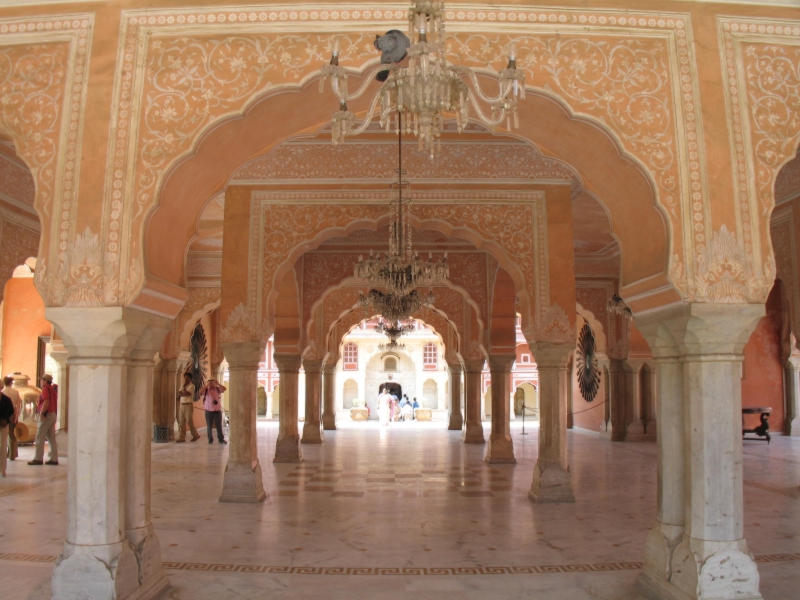Jaipur: "The Pink City"
Jaipur, Rajasthan
India
February 23, 2007
Dear Family and Friends,
Noise and dust pierce the senses. Construction cranes pierce the sky. Jaipur is crowded. Jaipur is "developing."
My gracious hosts at the Govind Niwas Guest House, Admiral and Mrs. Madhvendra Singh recall earlier days when in the evening they would relax on their veranda or in the spacious garden in front of their home
Now, the avenue is just too busy. My friends are resigned to the inevitable yet they continue to enjoy the beauty of their city.
How many travelers have I met who focus only on Jaipur, dusty and "developing?" Like my hosts, I seek out Jaipur, pink and attractive and "developed."
Adit Singh leads the way, first to Hawa Mahal, then to the Jantar Mantar, and finally the Vhandra Mahal and the City Palace Museum.[1]
Hawa Mahal or "Palace of the Winds" has become an icon of the city. Five stories high but only one room wide, it enabled the ladies of the harem to view the busy street below. The pink Baroque-like façade is a perfect backdrop for the lively markets.
Jantar Mantar is one of the five observatories built by Jai Singh II. I visited one of the others in Delhi. This one built between 1728 and 1734 has sixteen separate instruments (yantras), "a giant sculptural composition."[2]
Narivalaya Yantra calculates time by following the solar cycle. Unnatansha Yantra can determine the position of stars and planets at any time of the day or night. Ram Yantra determines the celestial arc from horizon to zenith, as well as the altitude of the sun. Jai Prakasah Yantra maps out the heavens. Laghu Samrat Yantra, inclined at latitude 27° North, Jaipur's latitude, calculates the local time up to an accuracy of 20 seconds. [2]
My favorite instrument is Rashivalaya Yantra, composed of twelve pieces, each of which represents a sign of the zodiac, and therefore faces a different constellation. This instrument, used by astrologers to draw up horoscopes, is the only one of its kind. I find my own zodiac sign; I recall my accurately foretold fortune, buried inside a Miami Beach Chinese restaurant fortune cookie: "You will travel to many lands." Have faith, ye of little faith.
The City Palace "occupies the heart of Jai Singh II's city. (Jaipur named by Jai Singh.) The City Palace has been home to the rulers of Jaipur since the first half of the 18th Century. The sprawling complex is a superb blend of Rajput and Mughal architecture, with open, airy Mughal-style public buildings leading to private apartments.
The tallest building of the complex is the Chandra Mahal, a seven story extravagantly decorated palace. It is closed to the public.
The part of the palace complex open to the public is the Maharajah Sawai Man Singh II Museum. Its treasures, which include miniature paintings, manuscripts, Mughal carpets, musical instruments, royal costumes and weaponry, provide a splendid introduction to Jaipur's princely past, and its fascinating arts and crafts.
[2]
My favorite treasures are the miniature paintings and the gigantic carpets. These hand woven carpets are so large that they are displayed from ceiling to floor. At the ceiling and on the floor, the ends of the carpets are wound on wide rollers.
Two large elephants, each carved from a single block of marble, guard the Rajendra Pol, the gateway to the Diwan-i-Khas.
Just outside the Diwan-I-Khas, the Hall of Private Audience, sit two giant silver urns, listed in the Guinness Book of Records as the world's largest silver objects. They carried sacred Ganges water for Madho Singh II's visit to London in 1901.
The Riddhi-Siddi Pol is the elaborate gateway to the Pritam Chowk, the "Court of the Beloved." The court has four exquisite and delicately painted doorways, each representing one of the seasons. They are stunning and dramatic.
Do you agree there is a pattern here in Rajasthan art and architecture? There is an emphasis, a contrast, it seems, between the feminine tiny and deliberate, and the masculine huge and majestic. A yin and a yang, if you will. Am I balanced? I enjoy them both.
My fellow art critics and museum goers, why wait for the fortuitous fortune cookie? Book a ticket to Jaipur - The Pink City. The palace alone is worth the trip. And yes, they have a gift shop. And an outdoor caf? where a duo plays and dances. And a guy with a flute and a cobra in a basket. And, a palmist.
Cheers,
Jan . . . Waiting for a reading [3]
[1] Adit is my new driver and guide. He speaks excellent English and is quite knowledgeable about Indian art, architecture and culture. And like me, he has had his share of challenging life experiences, so we chat and bond; I hope that our friendship will endure.
Since I planned to travel north from Jaipur to Bikaner, Suresh, my first driver, left Jaipur and completed the Golden Triangle on his own as he drove the hypotenuse, northeast, to return to Delhi.
[2] "India. Eyewitness Travel Guide." Dorling Kindersley Limited. London. 2005
[3]
Jan Robert
b. 18 September 19??
Wednesday Morning
Virgo
The Year of the Dragon
Now you know all my secrets. Almost.

